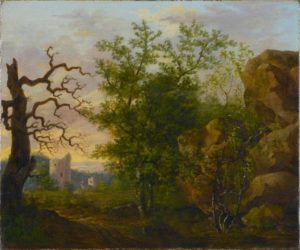Caspar David Friedrich, a celebrated figure of Romantic painting in Germany, is currently under the spotlight. A painting featured in an exhibition dedicated to his work has unexpectedly lost its attribution to the artist.
Like his British contemporary J.M.W. Turner, Caspar David Friedrich was most impactful in landscape painting. Specifically, he became known for emphasizing humanity’s contemplation of nature through works like Wanderer Above the Sea of Fog, The Abbey in the Oakwood, and The Monk by the Sea. They convey messages about the natural world’s enormity and its ability to withstand and overcome the chaos and destruction that might wreck human civilization. Several cultural institutions worldwide are preparing special events and exhibitions for his 250th birthday (on September 5th of this year). For example, the Metropolitan Museum of Art in New York will stage the first museum exhibition in the United States solely dedicated to Friedrich starting on February 8, 2025. The Dresden State Art Collection recently opened its own exhibition dedicated to the artist on August 24th, featuring highlights from the collection’s trove of Friedrich works. Entitled Friedrich: Where It All Started, the exhibition at the Albertinum’s Galerie Neue Meister displays the artist’s work and that of his colleagues and contemporaries alongside their Old Master predecessors like Lorrain and Ruisdael. One of the core goals of the exhibition is to dispel the longstanding myth that Friedrich was a misanthropic loner who created his oeuvre in relative isolation from Dresden’s artistic community. He had a widespread network of friends, acquaintances, and students, especially among the Central European Romantics like Carl Gustav Carus, Johan Christian Dahl, and Carl Robert Kummer. In the middle of it all, though, one painting on display previously attributed to Friedrich now has no attribution at all.
Landschaft mit kahlem Baum, or Landscape with a Bare Tree, had previously been attributed to Friedrich in many works of art historical scholarship, including Helmut Börsch-Supan’s 1980 catalogue raisonné. It has been part of the Dresden State Art Collection since 1983. Art historians previously attributed it to Friedrich’s time in Copenhagen in the 1790s, shortly before coming to Dresden, where he would live and work for nearly forty years. According to the museum’s new description, the painting is “difficult to match stylistically with the artist’s later paintings. […] Börsch-Supan classified this unusual work by the artist ‘in a transitional phase between the still ornamental tree depictions of the Copenhagen period and the beginning of the study of nature in Dresden’”. While some aspects of the work are similar to Friedrich’s later symbolic use of landscape elements, the Galerie Neue Meister specialists do not have confidence in a Friedrich attribution. According to these experts, the painting is devoid of “any possible substantive meaning” and lacks the “decisiveness of the painter’s future great pictorial inventions.” After testing, scans revealed that the underpainting is inconsistent with Friedrich’s style. Furthermore, the pigments used include shades of blue and yellow that European artists would not widely use for at least another decade after the painting’s estimated creation.
The Galerie Neue Meister continues to show the painting in the Friedrich exhibition despite its information card now reading “Unknown.” As a landscape created during Friedrich’s early years, it is regardless a way of showing the development of landscape painting at the dawn of the Romantic era in Central Europe. The exhibition Friedrich: Where It All Started will run at the Albertinum’s Galerie Neue Meister until January 5th.

